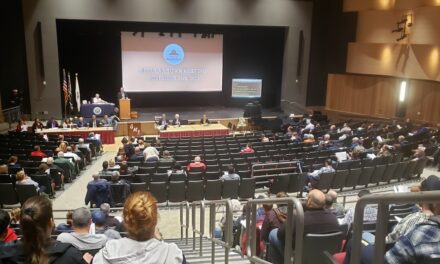Published in the July 24, 2018 edition.
By GAIL LOWE
WAKEFIELD — “Jaws” is a movie made in the mid-1970s that is embedded in the memories of most viewers due to its terrifying content.
Since the film’s release, many people have feared swimming in ocean water. Once you’ve seen it, the on-screen images are hard to get out of your mind.
The movie, released in 1975, still remains popular and Wakefieldians will be treated to a viewing, compliments of Wakefield Community Access Television (WCAT), on Thursday evening, July 26 on the shores of Lake Quannapowitt.
According to WCAT Executive Assistant Barbara Worley, “Jaws” received the most votes in the Movie by the Lake summer poll. The Wakefield Rotary Club also picked the movie to sponsor, said Worley.
“At nightfall, the movie is projected on a big screen by the Bandstand,” Worley said. “When’s this? When it’s dark enough to show the movie.” Rain date is Aug. 2.
Filmed on the 100-mile square island of Martha’s Vineyard, “Jaws” inadvertently involved two people with ties to Wakefield, and there could be more. If there are, the Daily Item has not heard. For details, read on.
In the spring of 1974, newspapers reported that a best-selling novel by Peter Benchley (“Jaws”) was being made into a movie. Casting personnel were looking for locals to work as actors, extras and general help on and off the water.
Universal Studios sought people who were familiar with fishing and fishing boats to serve as advisers because they wanted the film to be as authentic as possible. Wakefield resident Kristen Henshaw’s father Craig Kingsbury was encouraged by friends and family to try out for a role, and Police Chief Rick Smith was assigned to police detail at the filming sites. He was only 20 years old.
“My father wasn’t interested,” said Henshaw. “He didn’t have any use for movie stars and their ‘ilk.’ He said they were like Persian cats — nice to look at, but most of their fur grew on the inside of their heads.”
According to Henshaw, her father’s resistance changed the day his friend Hershel West called and told him the pay was $70 per day to “stand around and look stupid.”
“Dad said that he could both look and be stupid for that kind of money,” noted Henshaw. “He went right down to the casting office, and he was signed up right away.”
Apparently, the casting crew loved Kingsbury. He was 6’ 3” tall, rugged, tattooed and dressed in a tattered shirt and pants. He also showed up barefoot. While chewing snuff, he talked to the crew using colorful and memorable language.
“He spent most of his 62 years on the water and was a real fisherman,” said Henshaw.
Kingsbury’s most important contribution to the film happened when Casting Director Shari Rhodes assigned him to teach Robert Shaw, who played the part of Quint and was actually a refined British actor, how to talk like a “fish pier lowlife, a wharf rat,” said Henshaw.
Shaw needed a voice coach, and Kingsbury had the right stuff. Kingsbury read all of Shaw’s lines into a tape recorder so the actor could perfect the accent of a genuine New England fisherman. He also helped Carl Gottlieb, principal screenwriter, create dialogue that accurately reflected the language used by men on the water.
Because Kingsbury was such an unusual and engaging character and because film Director Steven Spielberg enjoyed his company, Kingsbury was given a small but unforgettable role: local fisherman Ben Gardner.
“Gardner becomes an early victim of a great white shark,” said Henshaw. “It’s his head that rolls out of the hull of his semi-sunken boat. It was a rubber mask of my father’s head that provided the loudest scream in a movie that has no shortage of scream-worthy scenes.”
A month after the movie’s release, Kingsbury was at Henshaw’s wedding. “Guests who had seen the movie thought that Dad had actually played Quint, a testament to Mr. Shaw’s skills at mimicry,” she commented. “Mr. Shaw had even grown longer sideburns to look more like my father.”
One wedding guest suggested that Kingsbury had been paid very well to be in the movie, to which he replied, “I’ll say. Seventy plunks a day — and that’s good money.”
Around the time of filming, Chief Smith worked details at Oak Bluffs and Edgartown on Martha’s Vineyard.
“I got to know Bruce the Shark as he rested in ‘Shark City’ in Oak Bluffs between shoots,” Chief Smith said.
He also met Shaw and Richard Dreyfus, who played the scientist from Woods Hole Oceanographic Institute as they wandered the island in the summer of 1974 when shooting began.
While the film is being shown on Thursday night, July 26, patrons are advised to keep an eye out for young boys in baseball caps selling popcorn and drinks to benefit the Jimmy Fund. Each summer, dozens of Wakefield players enter the Jimmy Fund’s summer baseball program, a competitive league in which teams play surrounding towns and, at the same time, try to raise money for the cancer-fighting cause.
Over the last five years, Wakefield teams have led their district in fundraising efforts.
Last year, through a number of events organized by Wakefield coaches and parents such as the Wiffle Ball Home Run Derby and haircut marathon, Wakefield teams amassed over $12,000. This year, the fundraiser will kick off with the sale of popcorn and drinks at the movie.
WCAT is an independent not-for-profit organization that does not receive any tax-based dollars from the town of Wakefield and returns over $3.1 million in services to the community per year.
Henshaw has written a book about her father’s life titled “Craig Kingsbury Talkin.” The book provides a more detailed picture of who Kingsbury was, using his own words. Tereski Press, 2005, $18.95. Call 781-246-2387 for a copy.




